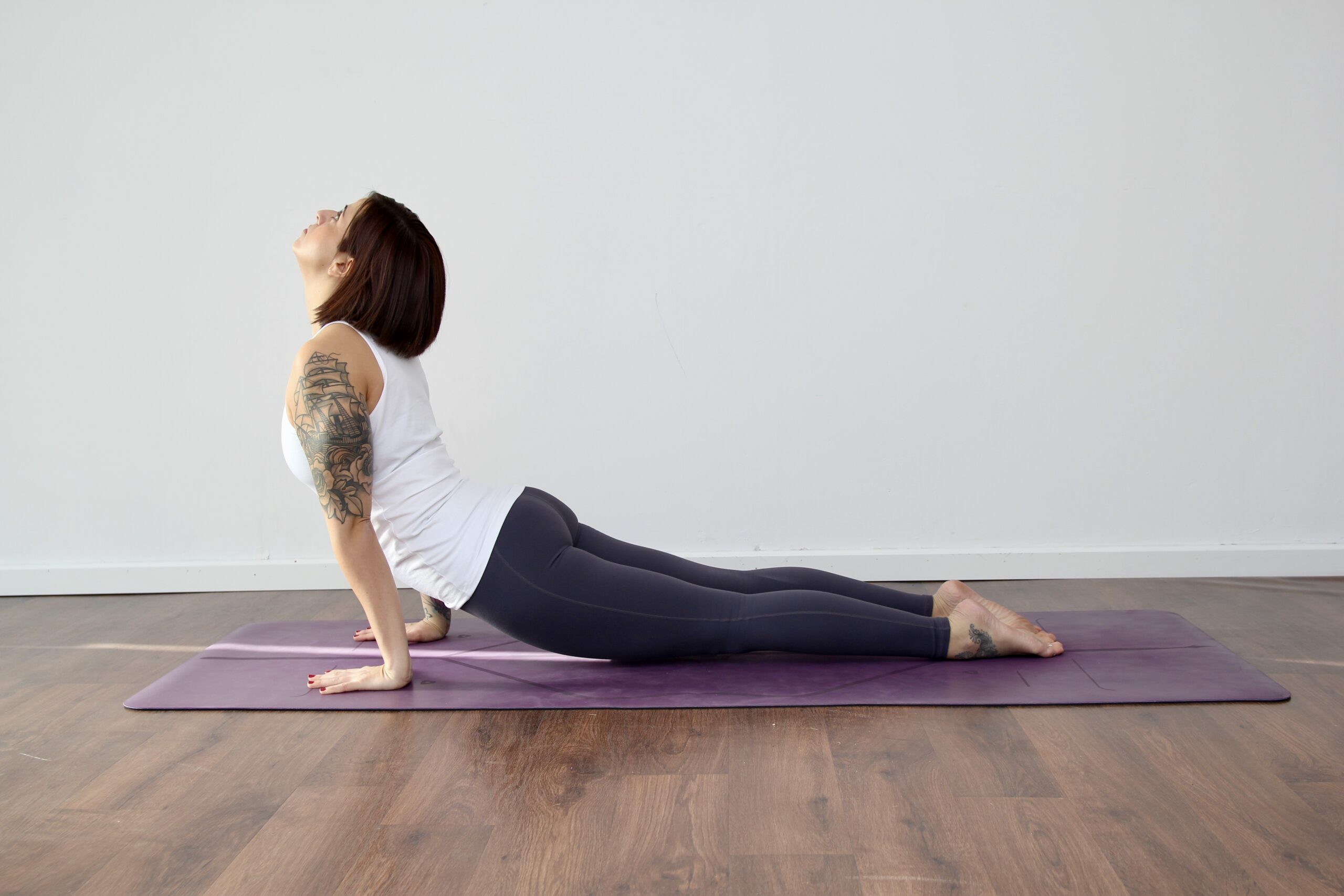In this article, you will learn about the basics of using polyvagal theory in yoga.
We will cover:
- What is the vagus nerve?
- What is the nervous system?
- How the nervous system responds to danger.
- Modern Day stressors.
- What can we do?
So lets begin…
Polyvagal theory was coined by Dr. Stephen Porges details how our vagus nerve is linked to our emotional, fear, and stress responses.
The Vegas nerve is the largest nerve in the body, it begins in the brain stem, runs through the face, and all down the front side of the body ending in the pelvis and the sex organs. It manages our respiratory system, our digestion, hormonal secretion in the body, and our limbic brain and emotional response.
The Vegas nerve is directly linked to our fight or flight response, this is how our whole body and the nervous system responds to danger. You may have heard of this before, but if not I will explain it in a little more detail further on in the article.
It’s helpful for us to look at the Vagus nerve as being part of a system that allows us to respond to danger and tries to keep us safe in the best possible way. It is the initial signal to the rest of the body, brain and nervous system which tells us how to respond, and behave.
What is the nervous system?
The nervous system is made up of two parts, on one side we have the parasympathetic nervous system which is better known as our rest and digest mode. And on the other side sits the sympathetic nervous system which is known as our fight-flight response or stress system.
Both sides of the nervous system are vital for our functioning and survival in life and both are controlled by the vagus nerve.
The nervous system in the body is an ancient, primitive system, one which hasn’t really evolved much over time. It is extremely animalistic in nature and functions without us even being aware of it.
Most of the responses are so quick and involuntary that we don’t even know they are happening. The nervous system and vagus nerve just continue doing its job keeping us alive and safe from danger.
While this process is mostly unconscious, we also have the capacity to become more aware of how our nervous system functions and responds.
The most effective way I’ve found to learn how to do this is through using our yoga practice. Yoga is an introspective practice. Meaning that over time we become more aware of our inner experience on a deeper level.
Once we have this awareness we can observe the reactions and processes happening with our fight flight response, and then we can choose how we want to respond. Instead of the system working on its own automatically and just reacting to outside stimulus on autopilot.
Creating awareness in this way allows us to have a little more control over our system, or at the very least the understanding of what is actually happening. Also, much simpler tools and techniques can be applied to our practice, but ill get to that a little later…
How the nervous system responds to danger.
So let’s imagine back, many years ago when we had stresses in our lives that would be a threat to our survival, such as large predator animals.
Upon seeing such threats our nervous system would respond in a particular way to help us do what we needed to do to survive, we move into the sympathetic nervous system, and the process in the body is this:

1. We see danger
2. Vagus nerve contracts and tells the body to prepare to fight or flight
3. In preparation to fight or flight the body responds by slowing down digestion to conserve energy
4. Breathing increases to pump more oxygen around the body so that we can run or have the strength to fight
5. Stress hormones such as cortisol, testosterone, and adrenaline will be produced for the same reason
6. All of this information is moving back and forth to the brain and we respond accordingly
Now, this is all wonderful, an involuntary response that does its job extremely well in keeping us alive and prolonging our species and survival… but what happens after the event has passed and the threat to life is no longer there?
In an ideal situation, the body and nervous system will move back into the parasympathetic system with ease which is our rest and digest mode, so that we can be back in homeostasis and function at our optimum level.
When we reside on that side of the nervous system the process in the body is more like this:
1. Vagus nerve releases when we know it is safe
2. Digestion works at its best
3. Heartbeat is slow and calm
4. Breathing is slow and calm
5. Feel good hormones such as dopamine, oxytocin, and endorphins are released
6. We are emotionally less reactive and calm
So as you can see each side of the nervous system has a vital role in our survival, so before I continue please understand that viewing one side as better than the other is not helpful.
There is nothing wrong with either of them and nothing wrong with you if you tend to find yourself more in the stress system.
Modern-day stressors.

We don’t have the threat of large predator animals in 2022, but our stressors in life might look and feel more like conflict with a partner or boss, stress with children, big T or small t trauma that’s left unresolved, PTSD, CPTSD or other mental health dysregulation.
Unfortunately due to the primitive nature of our nervous system, and the relationship between the vegus nerve and the limbic brain (which is our emotional response) it cannot tell the difference between different stressors, so even if an event or situation isn’t a direct threat to your life or survival the nervous system will respond in exactly the same way.
In our modern world, it’s becoming more and more apparent how stress in our lives continues to build. At times it may even feel like one thing after another, and there often isn’t a lot of time to stop, process, and find space in our busy lives to allow our nervous system to reset itself back.
So if you can imagine the body and mind getting stuck in the sympathetic nervous system for a lot of our lives, with all the things that I mentioned happening in the body above, over time this can have a massive impact on our overall physical and mental health.
So what can we do?
The wonderful thing about this entire system is that all parts affect and relate to one another. So if you trigger one, the rest will follow, if you release one part the rest will also follow.
Whilst this system is usually functioning involuntarily, knowing this theory and with a few tools under our belt, we also have the power to learn how to switch ourselves back to the parasympathetic nervous system by relaxing and releasing the vagus nerve!
Another great thing to remember is that the more we do this, the stronger our vagal tone will get, so we strengthen our response, and our nervous system gets much better at switching between the two states. And let’s face it, I’m sure we all want to feel a little calmer and sit in that rest and digest mode for a little longer right!?
So, there are in fact many ways to help strengthen our vagal tone, but as I said I have found the most effective way is through yoga. Due to the position of the vagus nerve reseting the nenrvous system is pretty simple.
Any posture or movement that lengthens and contracts the torso, so cat cows, cobra pose, backbends, spinal flexes, twists… you get the point, are all excellent contenders!
And as I mentioned earlier, yoga is an introspective practice, so every time we get on the mat, we direct our focus inward and learn more about ourselves, our experiences, and our reactions. This learning process creates awareness and therefore gives you more power over how you choose to respond, behave and live your life.
Pranayama (breathing) is also proven to help us reset our nervous system and move into the parasympathetic state, again under the same rule that, trigger one the rest follows, release one the rest follows.
Remember I said that the vagus nerve was responsible for our respiratory system too? While breathing is generally involuntary, once we learn how to control our breath we can gain control over our nervous system responses. I have on many occasion been able to breathe myself out of a panic attack quite quickly and change how I feel and how my body responds to any perceived threat.
So, the first step is realising that you can take your nervous system into your own hands and learn how to manage it and not let it manage you! The rest is as they say…practice.
Other ways to strengthen vagal tone include
– Whistling
– Singing
– Chanting
– Relaxing the face
– Long walk
– Running
– Laughing
– Swimming
– Massaging ears and neck
I hope you enjoyed learning about using polyvagal theory in yoga and start applying these tools to your self-care practice!

